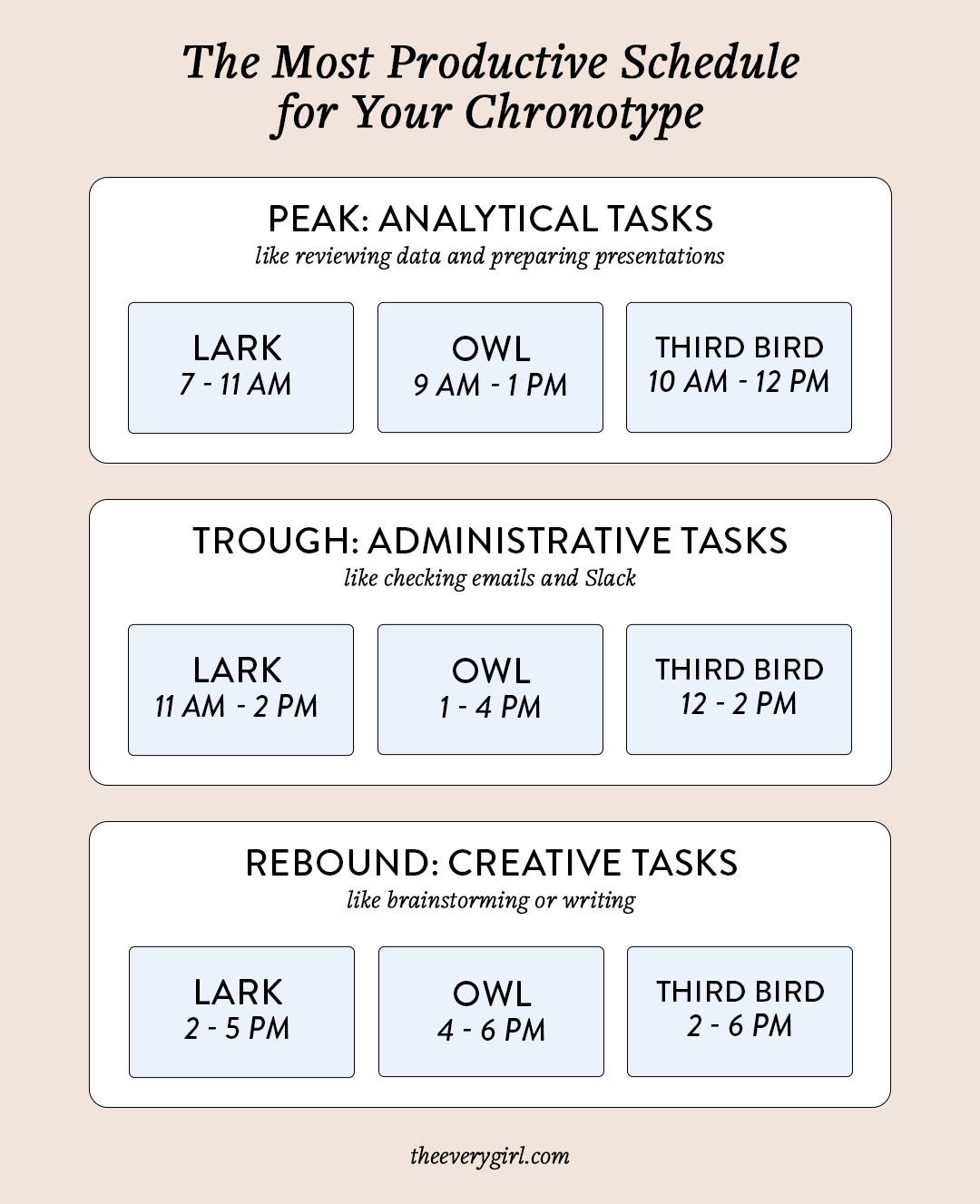
Do you ever feel like no matter how many productivity hacks, time management tips, or The Everygirl desk essentials you buy, you still aren’t operating at your peak productivity levels?
We’ve all heard the same advice from productivity experts everywhere, “Wake up an hour earlier!” or “Have you tried [insert time management strategy here]? It’s a total game-changer.” We live in a world where productivity is always top of mind, but sometimes, something still feels off no matter how many strategies we try or how much effort we put in.
If you’ve ever felt this way, you aren’t alone. But I’m here to tell you a little secret: You might have top-notch time management and productivity skills, but if you’re not structuring your day around your chronotype, you’re missing one of the puzzle pieces that will help you be successful.
As a self-proclaimed self-help enthusiast, I recently dug into Daniel Pink’s book When: The Scientific Secrets of Perfect Timing. Despite knowing as much as I do about productivity, I’ve never thought about how the timing I choose for specific work might not be a good fit. Naturally, I find open time in my calendar in the afternoons, a couple of hours before logging off for the day. But as it turns out, as a morning lark, I should actually be scheduling my focused work time in the morning hours.
If you’re looking for the real productivity hack that will help you get your best work done, look no further: Understanding your chronotype is the missing piece you’ve been searching for.
What are Chronotypes?
Each of us has a chronotype or a circadian classification of sorts. Our chronotype influences our alertness and activity levels, even when we don’t realize it. And since research suggests that our chronotypes are biological characteristics influenced by genetics and age, it’s often easier to work with your chronotype than against it or try to change it.
In his book, Pink shared the story of Thomas Edison alone in his lab one evening in 1879. While other colleagues went home to sleep, Edison stayed behind, determined to find a filament to illuminate a lightbulb. Pink uses Edison’s concept to introduce chronotypes you might be familiar with: larks and owls.
- Larks have early chronotypes and are generally what we refer to as “morning people.” They wake early (naturally, not after hitting the snooze button seven times) and feel energized throughout the day but start to wear out by the early evening hours. According to Pink, when it comes to personality characteristics, research reveals that morning people are pleasant and productive and high in positive affect.
- Owls have late chronotypes and are “night people.” They may sleep in when they don’t have to get up early for work and don’t peak (or do their best work) until late afternoon or early evening. Pink notes that owls tend to display darker tendencies, including impulsivity, sensation-seeking, and living for the moment.
But in addition to these two types, Pink introduces the third chronotype somewhere in the middle—the third bird.
- Third birds are in the middle—not inherently early risers or night people—but more like people who naturally wake sometime between 8-10 am. Many of us meet the third bird criteria.

Source: Tatiana Syrikova | Pexels
Why does my Chronotype matter?
Okay, our chronotypes certainly impact our sleeping patterns, but why do they matter at work? All of us, regardless of chronotype, similarly experience the day. The kicker: We don’t experience it at the same time in the day because of our chronotypes.
Every day, we experience three phases as part of our biological productivity:
A peak: The time of day where your energy, attention, and focus are at their highest.
A trough: The time of day where your energy levels are lowest, and you may find it challenging to focus.
A rebound: A boost in energy and attention (not quite the same levels as your peak, but more than your trough).
According to Pink, larks and third birds experience the day in that exact order, but at different time frames throughout the day (larks peak earlier than third birds, etc.); however, night owls might experience the day in reverse order, says Pink—a recovery, a trough, and a peak. (Keep this in mind, we’ll help you optimize your day once you figure out your type!)
How to determine your bird type
Determining your chronotype is relatively simple. You need to examine your behavior on a “natural” day—a day when you aren’t setting an alarm clock or forcing yourself to wake up at a specific time.
Pink recommends asking yourself the following three questions:
- What time do you usually go to sleep?
- What time do you usually wake up?
- What is the middle of those two times—that is, what is your midpoint of sleep?
Do you have your answers?
You’re probably a lark if your midpoint of sleep is before 3:30 am. You’re likely a third bird if it’s between 3:30-5:30 am. And if it’s after 5:30 am, you’re most likely an owl.
Still not convinced? Try Pink’s simpler method to be sure. Write down when you wake up on the weekend or a non-alarm clock day. If it’s the same as weekdays, you’re a lark. Slightly later than weekdays, a third bird. And one-and-half hours or more later, an owl.
How to make the most of your workday
Now that you know your chronotype, you can take advantage of the three phases of the productivity cycle: peak, trough, and rebound.
If you have some control over when you can do your work, try to plan to do your most critical analytical tasks during your peak. For larks and third birds, the morning to mid-morning hours is a sacred time that you should reserve for your most important tasks (you know, like that big assignment requiring research and critical thinking that your boss wants from you by the end of the week). Night owls don’t have it as easy, but saving important analytical tasks for the late afternoon and evening can benefit from a productivity standpoint. Here’s an example schedule for each of the three types:

Consider using your trough for lighter, administrative tasks that are more mundane and routine. For larks and third birds, a late afternoon time block for responding to emails and Slack messages might be the move. For owls, consider starting your morning this way—ease in slowly and get settled into your workday. Knowing when your trough is can also be helpful for scheduling meetings. Depending on the type of meeting and your role as an attendee, consider scheduling less critical, more routine meetings during your trough when your activity levels are lower.
There’s no secret recipe for living your best, most productive life, but knowing how (and when) you’ll do your best work can help. Don’t ditch those time management strategies and productivity hacks just yet! Combine them with a schedule that works well for your chronotype, and watch your work life soar in no time.
